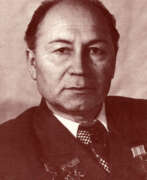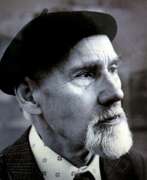Public figures USSR (1922-1991)
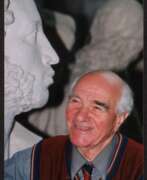

Mikhail Konstantinovich Anikushin (Russian: Михаил Константинович Аникушин) was a Soviet and Russian sculptor, celebrated for his monumental works that have left a lasting legacy in the art world. Born on September 19, 1917, in Moscow, Anikushin's sculptures are a testament to his profound skill and dedication to depicting historical and cultural figures with a dynamic expressiveness that brought them to life. His most notable works include monuments dedicated to Alexander Pushkin, found at the Pushkinskaya Station of the Saint Petersburg Metro and Arts Square in Saint Petersburg, as well as a monument to Vladimir Lenin at Moskovskaya Square in Saint Petersburg.
Anikushin's career was distinguished not only by his artistic achievements but also by the honors he received, reflecting the impact of his work on Russian culture. He was awarded the title of "Honored Artist of the RSFSR" in 1957, "People's Artist of the USSR" in 1963, and became a full member (academician) of the Russian Academy of Arts in 1962. His dedication to capturing the spirit and essence of his subjects, particularly Alexander Pushkin and Vladimir Lenin, showcases his innovative approach to sculpture, moving beyond traditional standards to depict his subjects in active, dynamic poses.
The Presidential Library collection dedicated to Anikushin commemorates the 100th anniversary of his birth, highlighting his significant contributions to Russian sculpture in the 20th century. Anikushin's works are integral to the aesthetic and cultural landscape of Leningrad (now Saint Petersburg), contributing to the city's historical and artistic identity. The collection also emphasizes his role in the community, including his public service and the enduring influence of his artistic vision on generations to come.
Collectors and experts in art and antiques recognize Mikhail Konstantinovich Anikushin not only for his technical prowess but also for his ability to imbue his sculptures with a sense of movement and emotional depth that resonates with viewers. His works remain landmarks, celebrated both in Russia and internationally, for their contribution to the cultural heritage.
For those interested in exploring the works and legacy of Mikhail Konstantinovich Anikushin further, signing up for updates can provide invaluable insights into new discoveries, exhibitions, and auction events related to this influential sculptor. This subscription is an opportunity to stay informed about the sales and exhibitions that continue to celebrate Anikushin's remarkable contribution to the world of sculpture.
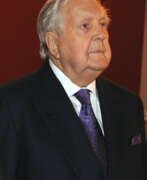

Ilya Sergeyevich Glazunov (Russian: Илья́ Серге́евич Глазуно́в) was a distinguished Soviet and Russian artist, born on June 10, 1930, in Leningrad, and passing away on July 9, 2017, in Moscow. Glazunov was not just a painter; he was a visionary and an educator who founded the Russian Academy of Painting, Sculpture, and Architecture in Moscow, where he also served as rector until his death. Glazunov's artistry was deeply rooted in historical and religious themes, as seen in masterpieces like Russia the Eternal, The 20th Century Mystery, and The Ruining of the Temple on Easter Night, along with his celebrated illustrations for Fyodor Dostoyevsky's works.
Glazunov's contribution to Russian art and culture was immense. He was a full cavalier of the Order "For Merit to the Fatherland," among other honors, acknowledging his significant role in the national art scene and education. Notably, during the 1970s, Glazunov played a key role in saving parts of Moscow's historic center from destruction due to proposed restoration plans, showcasing his commitment not only to the arts but also to preserving Russia's cultural heritage.
Collectors and experts in art and antiques admire Glazunov for his unique blend of artistic brilliance and dedication to cultural preservation. His works, which are held in high esteem across the globe, are a testament to his skill, vision, and unwavering love for his homeland. For those intrigued by Glazunov's legacy and wishing to explore his works further, subscribing for updates on new sales and auction events related to Ilya Sergeyevich Glazunov is highly recommended. This subscription is an invaluable resource for staying informed about opportunities to own a piece of Russian art history.


Andronik Grigorievich Lazarchuk (Russian: Андроник Григорьевич Лазарчук) was a Ukrainian and Soviet artist, born on January 15, 1870, in Ukhovetsk, Volhynian Governorate, and passed away on September 6, 1934, in Borzna, Chernihiv region. Known for his contributions to painting, teaching, and cultural activities, Lazarchuk's work primarily featured portraits, everyday scenes, and landscapes.
Lazarchuk began his artistic journey studying icon painting in Kovel and later in the Pochaev Lavra's painting workshop. From 1889 to 1897, he attended the Higher Art School at the Imperial Academy of Arts in St. Petersburg, where he studied under prominent artist Vladimir Makovsky. His artistic style was influenced by his early religious training, which is evident in his detailed and expressive portraits and landscapes.
One of his notable works, "Portrait of a Man," showcases his ability to capture human emotion and character. His other works include small-format paintings like "Reading a Letter" and "Family Group," which highlight his focus on everyday life and personal interactions. Lazarchuk also contributed to the decoration of Ukrainian churches, such as the Holy Trinity Church and the Cave Churches of Pochaev Lavra, and worked as an illustrator for magazines like "Native Land" and "Young Ukraine".
Collectors and art enthusiasts can explore Lazarchuk's legacy by signing up for updates on new product sales and auction events related to his works. This subscription will keep you informed about opportunities to acquire pieces by this influential artist.


Yehuda Pen (Russian: Юдель Моисеевич Пэн) was a Jewish-Belarusian artist-painter and teacher, recognized for his pivotal role in the Jewish Renaissance in Russian and Belarusian art at the start of the 20th century. Born on May 24, 1854, in Novoalexandrovsk (now Zarasai, Lithuania), Pen emerged as a significant figure, arguably paralleling Mark Antokolski's impact in sculpture. After moving to Vitebsk in 1891, Pen established the first Jewish art school in Belarus, offering training to many, including Marc Chagall, Ossip Zadkine, and El Lissitzky, who could not afford or gain admission to larger academies.
Pen's life was tragically cut short when he was murdered at his home in Vitebsk on the night of February 28/March 1, 1937, under unclear circumstances. His legacy, however, lives on through his works, primarily housed in Belarusian museums, including the Vitebsk Museum of Modern Art and the Belarusian National Arts Museum. Notable works include "Letter from America" (1903), "Old Tailor" (1910), and "Self-portrait with Muse and Death" (1925), showcasing his mastery in portraying everyday life and Jewish cultural themes.
Art collectors and enthusiasts keen on exploring the depths of Jewish art's evolution in the early 20th century would find Pen's work both intriguing and enriching. To stay updated on exhibitions and sales featuring Yehuda Pen's art, signing up for updates is highly recommended. This subscription will alert subscribers to new product sales and auction events related to Yehuda Pen, ensuring they don't miss out on owning a piece of history.
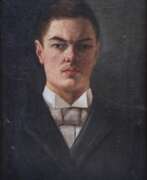

Kuzma Sergeyevich Petrov-Vodkin (Russian: Кузьма Сергеевич Петров-Водкин), a Russian painter, synthesized various traditions of global art, crafting a unique and deeply personal visual language. Born in 1878 in Khvalynsk, Saratov oblast, Russian Empire, Petrov-Vodkin is celebrated for his innovative approach to perspective, color, and composition, which positioned him as a pivotal figure in the art world of his time. He passed away in 1939 in Leningrad, now known as St. Petersburg, Russia.
Petrov-Vodkin's education in the arts took him from the Baron Stieglits School in Saint Petersburg to the Moscow School of Painting, Sculpture, and Architecture, where he was mentored by notable artists such as Valentin Serov. His studies abroad, including in Munich under Anton Ažbe, further enriched his artistic development. Notably, his marriage to Maria Jovanovic in Paris in 1906 marked a significant personal chapter, providing him with a lifelong companion and collaborator.
His work is distinguished by the use of "spherical perspective," a technique that distorts the drawing to emphasize the globe's curvature, making the viewer feel simultaneously distant and intimately close to the subject. This method, influenced by Byzantine iconography's inverted perspective, is evident in works like "Death of a Commissar" and "In the Line of Fire." Petrov-Vodkin's palette darkened over time, and his subjects diversified to include still life and portraiture, reflecting a broader exploration of theme and form. Despite facing health challenges, including pulmonary tuberculosis which limited his painting in later years, he remained prolific in other creative avenues, including literature, where his semi-autobiographical works are held in high regard.
His legacy is enshrined in the Russian Museum in St. Petersburg, which houses the largest collection of his works and dedicates a room to his art in their permanent exhibition. Additionally, a memorial museum in his hometown of Khvalynsk pays tribute to his contributions to Russian and Soviet art.
For collectors and art and antiques experts intrigued by Petrov-Vodkin's profound impact on Russian art, signing up for updates can ensure access to the latest sales and auction events related to his oeuvre. This subscription is a gateway to exploring the depth and breadth of Petrov-Vodkin's artistic achievements and ensuring enthusiasts are well-informed of opportunities to engage with his work.
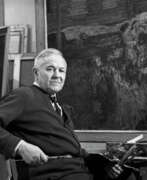

Arkady Alexandrovich Plastov (Russian: Аркадий Александрович Пластов), a luminary of Soviet art, was a Russian painter whose oeuvre is a testament to the simplicity and beauty of peasant life, making him a key figure in the realm of Soviet realism. His legacy is celebrated across Russia, with his works featured in prestigious institutions such as the State Tretyakov Gallery, Smolensk State Museum-Reserve, and the State Russian Museum in St. Petersburg, among others. Plastov's unique approach to art did not confine itself within the strict boundaries of socialist realism; instead, it traversed the depiction of peasant daily life and the intrinsic harmony between humans and nature.
Born into a family with deep roots in icon painting, Plastov's journey in art commenced in Prislonikha, Ulyanovsk province, where the landscapes and people of his hometown became the central theme of his work. Despite the hardships of a fire in 1931 that destroyed much of his early work, Plastov's resilience led him to create masterpieces that resonated with the Soviet populace. His dedication to portraying the truth of peasant life, through the lens of genuine admiration and respect for its beauty, earned him accolades such as the Stalin Prize, Lenin Prize, and the title of People's Artist of the USSR.
Plastov's paintings like "Haymaking," "Harvest," "First Snow," and "Spring" are vivid narrations of rural life, blending the everyday with the idyllic, thereby encapsulating the essence of Russian culture and its landscape. His works serve not only as historical records but also as celebrations of the human spirit and its connection to the land.
For collectors and experts in art and antiques, Plastov's paintings offer a glimpse into the soul of Soviet Russia, capturing the unadulterated beauty of its countryside and the resilience of its people. His art is a bridge between the past and present, reminding us of the enduring spirit of humanity against the backdrop of history.
To stay updated on exhibitions and auctions featuring Arkady Alexandrovich Plastov's work, sign up for updates. This subscription ensures you'll be the first to know about new sales and events related to this illustrious artist, keeping you connected to the heart of Soviet realism and Russian art tradition.
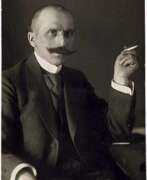

Vilhelms Kārlis Purvītis was a Latvian landscape painter and educator, celebrated for his profound influence on Latvian art and culture. Born in 1872 in the Kreis Riga area of the Governorate of Livonia, Purvītis is renowned for his mastery in capturing the neo-romantic atmosphere of Latvian nature through his paintings. He studied at the Imperial Academy of Arts in Saint Petersburg under Arkhip Kuindzhi, graduating with the Grand Gold Medal in 1897. His works, such as "Winter" (1910) and "Spring Waters (Maestoso)" (1911), showcase his evolution from Realism to Impressionism, influenced by European masters and movements like Art Nouveau.
Purvītis's contribution to Latvian art extends beyond his paintings. He founded the Latvian Academy of Art and served as its first rector from 1919 to 1934, shaping a generation of Latvian artists. His leadership roles at the Art Academy of Latvia and the Latvian National Museum of Art were pivotal in promoting Latvian art internationally, especially during the Republic of Latvia period. Despite personal losses, including the destruction of his house and many works during WWII, Purvītis's legacy endures through his influential teaching and the Purvītis Prize, established to recognize contemporary achievements in visual arts in Latvia.
For collectors and experts in art and antiques, Vilhelms Kārlis Purvītis's work represents not only a high point in Latvian landscape painting but also an embodiment of the country's rich cultural heritage. To stay updated on new discoveries, sales, and auction events related to Purvītis's work, signing up for updates is highly recommended. This ensures that enthusiasts and collectors alike are always informed about opportunities to engage with the legacy of this remarkable Latvian artist.
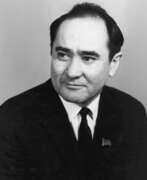

Mukhamedkhanafia Telzhanov (Russian: Мухамедханафия Тимирбулатович Тельжанов) was a distinguished Soviet and Kazakh artist, renowned for his expansive body of work that includes monumental paintings on revolutionary and military themes, genre pictures depicting the life of the Kazakh people, triptychs, landscapes, and portraits. Born on May 1, 1927, in what was then the Soviet Union, Telzhanov's artistic journey spanned across the mid to late 20th century, during which he made significant contributions to the world of art, embodying the spirit and culture of Kazakhstan through his creations.
Telzhanov's education and career were marked by notable achievements, including his studies in Saint Petersburg and Almaty, followed by his completion of studies at the prestigious Leningrad Institute of Painting, Sculpture, and Architecture named after I.E. Repin. His works, such as "Amangeldy Imanov" (1953), "The First Time" (1954), "Change", "Zhamal", "Mama Amina", and "Sounds of Dombra" (1955), among others, reflect his deep connection to his homeland and its people. Telzhanov's dedication to portraying the beauty, culture, and struggles of the Kazakh people earned him recognition as a People's Artist of the USSR and a corresponding member of the USSR Academy of Arts.
Beyond his artistic contributions, Telzhanov played a significant role in the educational realm, impacting the next generation of artists through his teaching positions at various institutions, including the Almaty Art and Theatre School, and later, the Kazakhstan State Art Gallery (now known as the A. Kasteev State Museum of Arts). His tenure as a professor and his leadership roles within the artistic community underscored his commitment to nurturing and advancing the arts within Kazakhstan.
Telzhanov's legacy is celebrated not only through his artworks but also through his contributions to the cultural and educational landscape of Kazakhstan. His works, characterized by their emotional depth and technical skill, continue to inspire art lovers, collectors, and students of art history, reflecting the enduring significance of his contributions to the cultural heritage of Kazakhstan.
For collectors and experts in art and antiques, the work of Mukhamedkhanafia Telzhanov represents a unique intersection of historical significance and artistic mastery. We invite you to sign up for updates related to new product sales and auction events featuring Telzhanov's work, ensuring you stay informed about opportunities to own a piece of this remarkable artist's legacy.


Nikolai Vasilyevich Tomsky (Russian: Никола́й Васи́льевич То́мский) was a distinguished Soviet sculptor, born in 1900 in the village of Staro Ramushevo, Novgorod province, into a family of a blacksmith. He became known for his monumental works that played a significant role in the artistry of the Socialist Realism era. Tomsky's educational journey in art commenced in Leningrad, where he graduated from the Arts and Crafts College in 1927. His rise to prominence began with his acclaimed memorial to Sergey Kirov, earning him the Stalin Prize in 1941. His work extended to designing Lenin's sarcophagus, creating Stalin's bust, and sculpting numerous statues of Lenin across the Soviet Union, including the notable red-granite Lenin in East Berlin.
Throughout his career, Tomsky received numerous accolades, including the title of Hero of Socialist Labor in 1970, multiple Orders of Lenin, and the Lenin Prize in 1972 for his granite monument of V.I. Lenin in Berlin. He was a laureate of the Stalin Prizes multiple times, received the USSR State Prize in 1979, and the State Prize of the RSFSR named after I.E. Repin in 1975 for his monument to M.I. Kutuzov in Moscow. His contributions to Soviet art were not only recognized in the USSR but also in the GDR, where he received the Order of Karl Marx.
Tomsky's works are celebrated for their ideological significance and artistic value, representing the Socialist Realism style's epitome. His sculptures, which include memorials to prominent Soviet figures and heroic compositions, are part of the cultural heritage of the Soviet era. For art collectors and experts in the field, Tomsky's creations offer a fascinating insight into the period's artistic and political landscape.
For those interested in the works and life of Nikolai Vasilyevich Tomsky, staying informed about new findings, sales, and auction events is essential. Signing up for updates can provide exclusive access to the latest information and opportunities to acquire pieces associated with this pivotal artist.
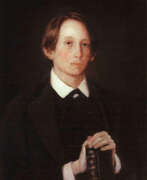

Apollinariy Mikhailovich Vasnetsov (Russian: Аполлина́рий Миха́йлович Васнецо́в) was a distinguished Russian painter and architect, celebrated for his pivotal role in bridging the realms of historical and landscape painting with a unique artistic vision. Born into a family with a deep artistic lineage, Vasnetsov's work was heavily influenced by Russian culture, history, and the natural landscape, which he depicted with a meticulous attention to detail and a vivid imagination. His specialization in creating historically accurate and vividly imagined views of ancient Russia set him apart from his contemporaries and solidified his status as a key figure in the Russian art world.
Vasnetsov's oeuvre is notable for its dedication to showcasing the beauty and complexity of Russia's past. His paintings often feature medieval and ancient Russian cities, imbuing them with a sense of romanticism and nostalgia. Among his most renowned works are his breathtaking views of the old Moscow, which are celebrated for their historical accuracy and atmospheric depth. These pieces not only offer a window into the past but also reflect Vasnetsov's profound love and understanding of Russian history. His works are housed in prestigious museums and galleries across Russia, serving as a testament to his lasting impact on the art world.
For collectors and experts in art and antiques, Vasnetsov's work represents a unique investment in Russian culture and heritage. His ability to weave together historical accuracy with artistic beauty makes his paintings highly sought after. We invite enthusiasts and collectors to stay informed on new discoveries, product sales, and auction events related to Apollinariy Mikhailovich Vasnetsov's work by signing up for updates. This subscription is your gateway to the latest offerings and opportunities to add a piece of Russian history and culture to your collection.
